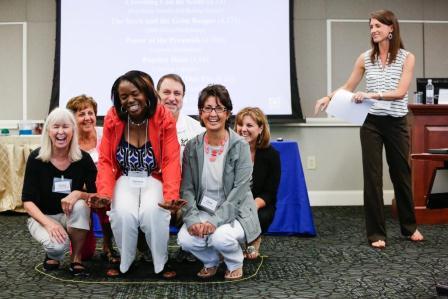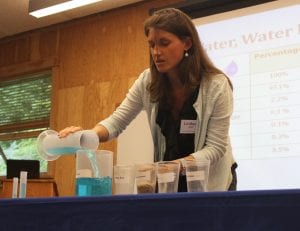As we posted last week, no classroom is too young to talk about population issues. Crowding Can Be Seedy takes global themes like population density and resource distribution and looks at them on a much smaller scale: seeds inside a flower pot. The teacher marks a circle on the floor to represent a flower pot using yarn or masking tape, and asks one student to crouch in the middle and represent a seed. After the class says a catchy poem that encourages the seed to rise up and spread her petals, the teacher asks the newly-formed flower whether she has enough room for her roots to grow, access to sunlight, etc. With only one flower in the pot, there are plenty of resources to go around—but this changes as the teacher adds more and more seeds to the pot. Eventually the flowers find themselves crowded together and unable to spread their petals.
 The students in the pot often find it amusing to be bunched together (groups of adults in workshop settings are less enthusiastic), but the goal is to spark a conversation about what happens when the flower pot becomes crowded. The number of flowers increases while the pot stays the same size, and eventually there is not enough room for the flowers’ roots or access to the water and sunlight necessary to grow into healthy plants. Teachers can link this to the idea of crowding in the real world: what happens we when continue to add more people, but the planet stays the same size? They can also introduce vocabulary words like “resource” and talk about the things humans need to survive—and how there is less to go around as world becomes increasingly crowded.
The students in the pot often find it amusing to be bunched together (groups of adults in workshop settings are less enthusiastic), but the goal is to spark a conversation about what happens when the flower pot becomes crowded. The number of flowers increases while the pot stays the same size, and eventually there is not enough room for the flowers’ roots or access to the water and sunlight necessary to grow into healthy plants. Teachers can link this to the idea of crowding in the real world: what happens we when continue to add more people, but the planet stays the same size? They can also introduce vocabulary words like “resource” and talk about the things humans need to survive—and how there is less to go around as world becomes increasingly crowded.
There is an excellent follow-up activity where students plant radish seeds in paper cups and compare what happens when a single seed is planted in each cup versus multiple seeds. This helps reinforce the idea of crowding and ensures that the lesson is not short-lived.
With an interactive simulation—and the chance to get their hands dirty—Crowding Can Be Seedy is an excellent way to introduce young learners to the issue of population growth. You can find a demonstration video of this and other activities by clicking here.




